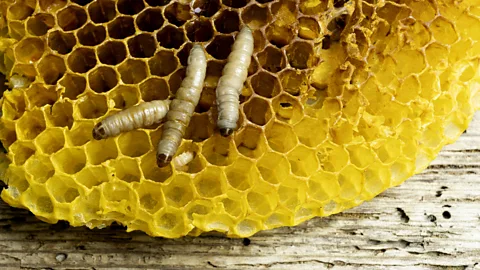Watch these hungry waxworms eat through plastic and digest it too
 Getty Images
Getty ImagesWriggling critters armed with enzymes can break down plastics that would otherwise take decades, or even centuries to degrade.
At first glance there's nothing particularly remarkable about waxworms. The larval form of wax moths, these pale wriggling grubs feed on the wax that bees use to make their honeycomb. For beekeepers, the pests are something to swiftly get rid of without a second thought.
But in 2017 molecular biologist Federica Bertocchini, who at the time was researching the embryonic development of vertebrates at the Spanish National Research Council, stumbled on a potentially game-changing discovery about these creatures.
Bertocchini, an amateur beekeeper, threw some of the waxworms in a plastic bag after cleaning her hive, and left them alone. A short time later, she noticed the worms had started producing small holes in the plastic, which begun degrading as soon as it touched the worms' mouths.
"It was a real eureka moment – it was brilliant," Bertocchini says about the initial discovery and the realisation of what it meant. "It was the beginning of the story. The beginning of the research project, of everything."
The worms were doing something that we as humans find remarkably difficult to do: break down plastic. (Read about the human effort to break plastic down through "chemical recycling".) Not only that, but the worms appeared to be digesting the plastic as though it was food.
Watch the video below from BBC Earth Science to see the worms at work.
Bertocchini and her fellow researchers began collecting the liquid excreted from the worms' mouths. They found this "saliva" contained two critical enzymes, Ceres and Demeter – named after the Roman and Greek goddesses of agriculture, respectively – which were able to oxidise the polyethylene in the plastic, essentially breaking down that material on contact.
Plastic planet
Today, 400 million tonnes of plastic waste is produced globally every year.
Of that, 19 to 23 million tonnes (about 2,000 garbage trucks' worth) seeps into aquatic ecosystems, where much of it is colonised by microorganisms or eaten by animals.
Plastics take anywhere from several decades to centuries to fully break down.
Letting these worms loose in a plastic-polluted environment could be dangerous to ecosystems, especially given their ability to destroy bees' hives, as Bertocchini notes. But she's hopeful that the enzymes these worms produce could help tackle the world's plastic pollution crisis.
Bertocchini is now chief technology officer at bioresearch startup Plasticentropy France, working with a team to study the viability of scaling up these enzymes for widespread use in degrading plastic.
"The big-picture goal is to be able to apply these enzymes to the plastic waste," says Bertocchini. "I really want this discovery and technology to be developed and transformed into a solution that we could use globally."
Promising enzymes could be found in a number of different organisms. Some fungi and bacteria are known to digest plastics, but it is much rarer in complex animals. In 2022, another invertebrate was discovered to have a taste for plastic – the "superworm" Zophobas morio, which can put on weight from a diet of polystyrene.
More like this:
Numerous global measures will be needed to reduce our reliance on and consumption of plastic. To this end, many countries have pledged to help reduce single-use plastic production and use, and a global plastics treaty is expected in late 2024.
But if enzymes like these can eventually be mass-produced to break down plastic, there could perhaps also be a role to play by the tiny critters that first munched their way out of Bertocchini's plastic bag.
If you haven't already, check out the video above from BBC Earth Science's Planet Fix to learn more about how worms, bacteria and enzymes can digest plastic.
--
For essential climate news and hopeful developments to your inbox, sign up to the Future Earth newsletter, while The Essential List delivers a handpicked selection of features and insights.
